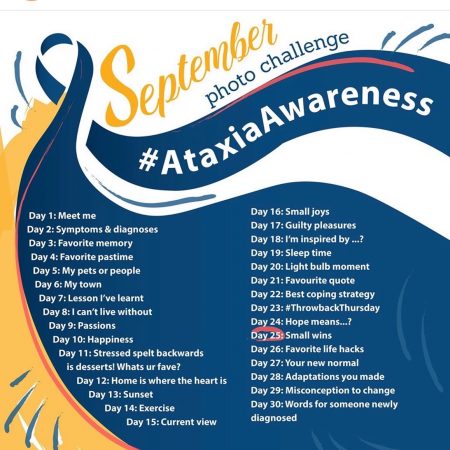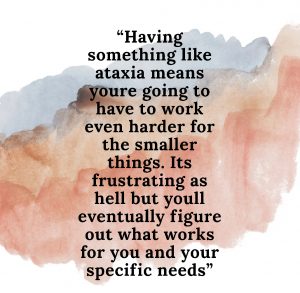What I Would Tell Someone Newly Diagnosed With FA

This September, I participated in a social media campaign to raise awareness for ataxia. Those who participated had to post a photo every day that corresponded with the prompts on the graphic below.
The graphic was created by a woman named Amanda. She has a different type of ataxia than I do, but she created the photo challenge to raise awareness on Sept. 25, International Ataxia Awareness Day, and throughout the month.
When I first glanced over the graphic and saw what each day entailed, I thought participating would be a great opportunity to re-introduce myself on Instagram. Recently, I have been through much that has led to personal growth, so this challenge seemed perfect.
Each day, I was challenged to look honestly at my soul and at who I am. This might have been just a photo challenge, but it was very therapeutic and allowed me to see ataxia from others’ perspectives.
I thought about my response to the last prompt for a while. It asked us to share words for someone newly diagnosed.
I quickly pulled a quote from something I have been working on. I slapped it on a pretty background, and it kind of looked like I knew what I was doing. After posting my image, I sat with the prompt and thought, “What would I have wanted to hear when I was first diagnosed?”
After posting my image, I sat with the prompt and thought, “What would I have wanted to hear when I was first diagnosed?”
Maybe I should have asked myself that before? But I digress.
I wish someone had told me that I would still be able to do things that make me happy. It is very possible to adapt these activities so you can still enjoy them. It comes down to how bad you want to do something and if you’re willing to put in the effort to find the methods that work for you.
When I was first diagnosed, I felt extremely hopeless. I gave away all of my high heels because I thought I’d never be able to wear them again. Although I had gone back and forth on that decision for years, it was finally time I had a concrete answer.
No one told me I’d still be able to rock those heels in my wheelchair. I had to learn that on my own, listen to my body, and buy new shoes for my new attitude.
Physical hobbies are pretty easy for ataxians to adapt. We can do a lot as long as we stay safe and have proper supervision or help if needed. We should enjoy ourselves and others, but not let the activity get out of hand.
However, hobbies such as reading, cooking, and traveling require massive amounts of planning as well as the motivation to adapt them.
Of course, we have to be realistic about our expectations and the energy we expend on those activities.
For example, becoming a marathon runner or professional gymnast with a disorder such as Friedreich’s ataxia probably isn’t realistic for most of us. It’s extremely frustrating to be unable to do many things, but it’s also important to focus on what we can do with both passion and grace.
Happiness is measured by our engagement in things we love. There’s enough negativity in the world, and we are often so harsh on ourselves. We deserve something that makes us genuinely happy.
If we can find a break from everyday stressors in adaptations of our favorite activities, why not work for them?
***
Friedreich’s Ataxia News is strictly a news and information website about the disease. It does not provide medical advice, diagnosis or treatment. This content is not intended to be a substitute for professional medical advice, diagnosis, or treatment. Always seek the advice of your physician or another qualified health provider with any questions you may have regarding a medical condition. Never disregard professional medical advice or delay in seeking it because of something you have read on this website.The opinions expressed in this column are not those of Friedreich’s Ataxia News or its parent company, Bionews, and are intended to spark discussion about issues pertaining to Friedreich’s ataxia.







Leave a comment
Fill in the required fields to post. Your email address will not be published.